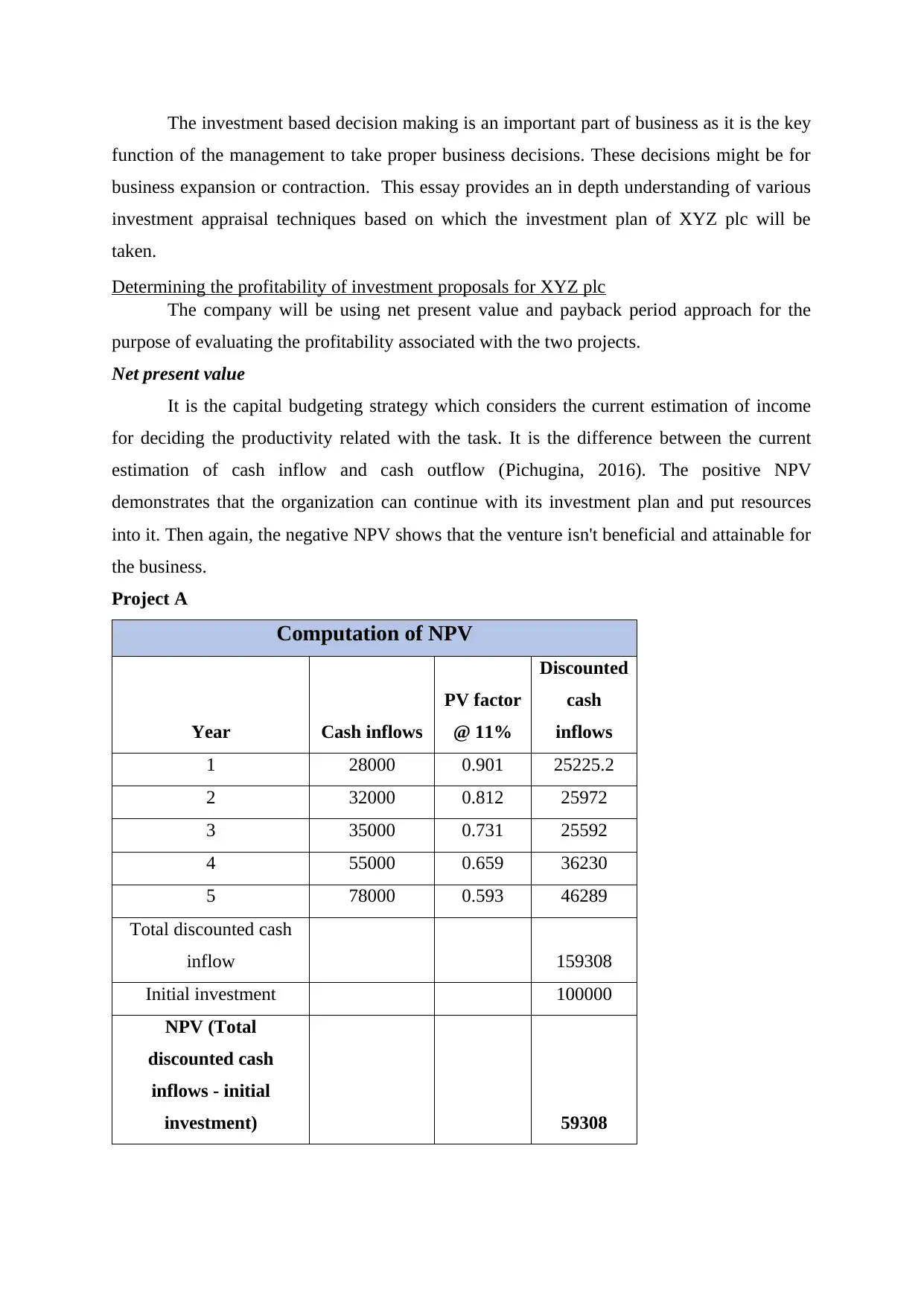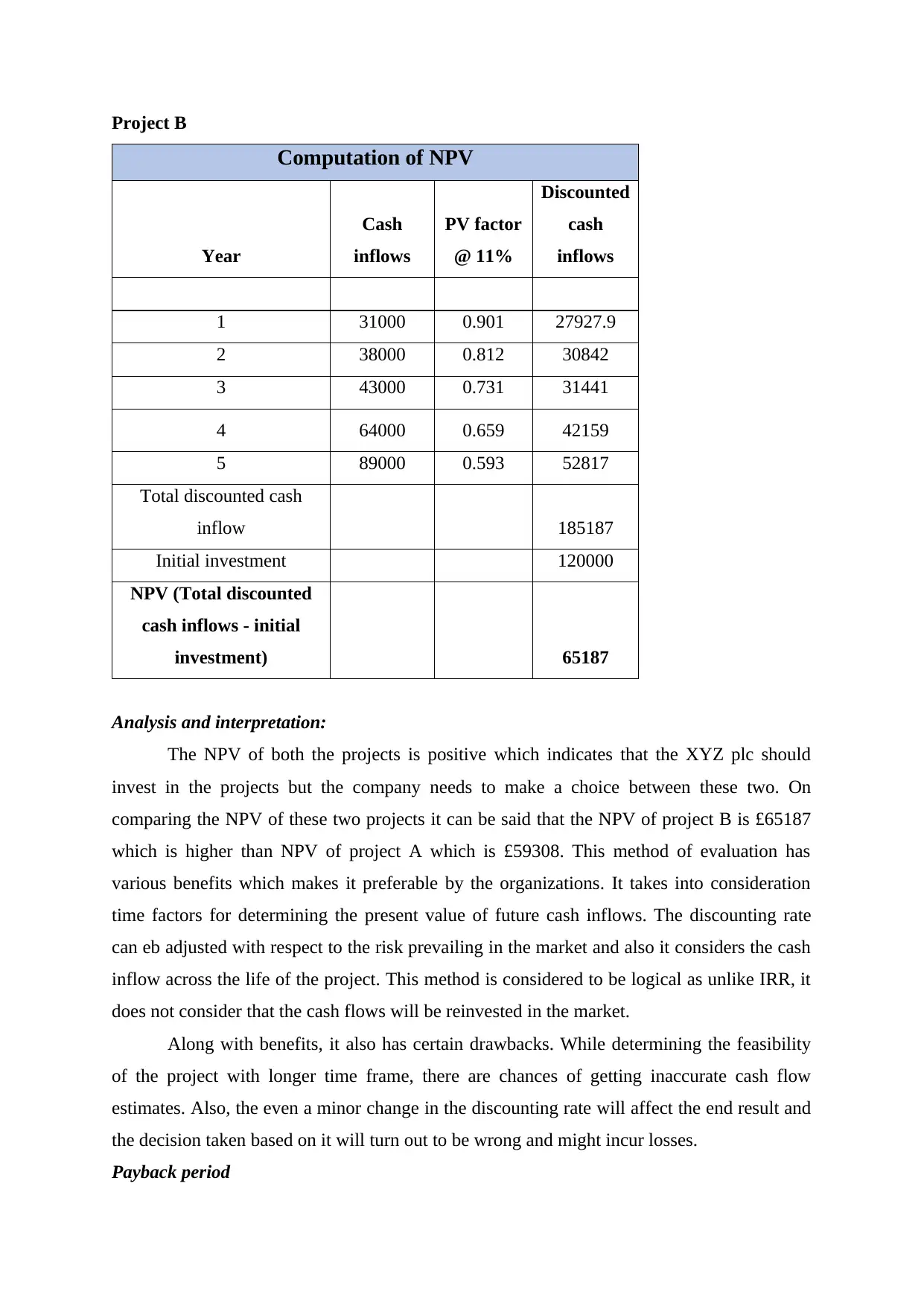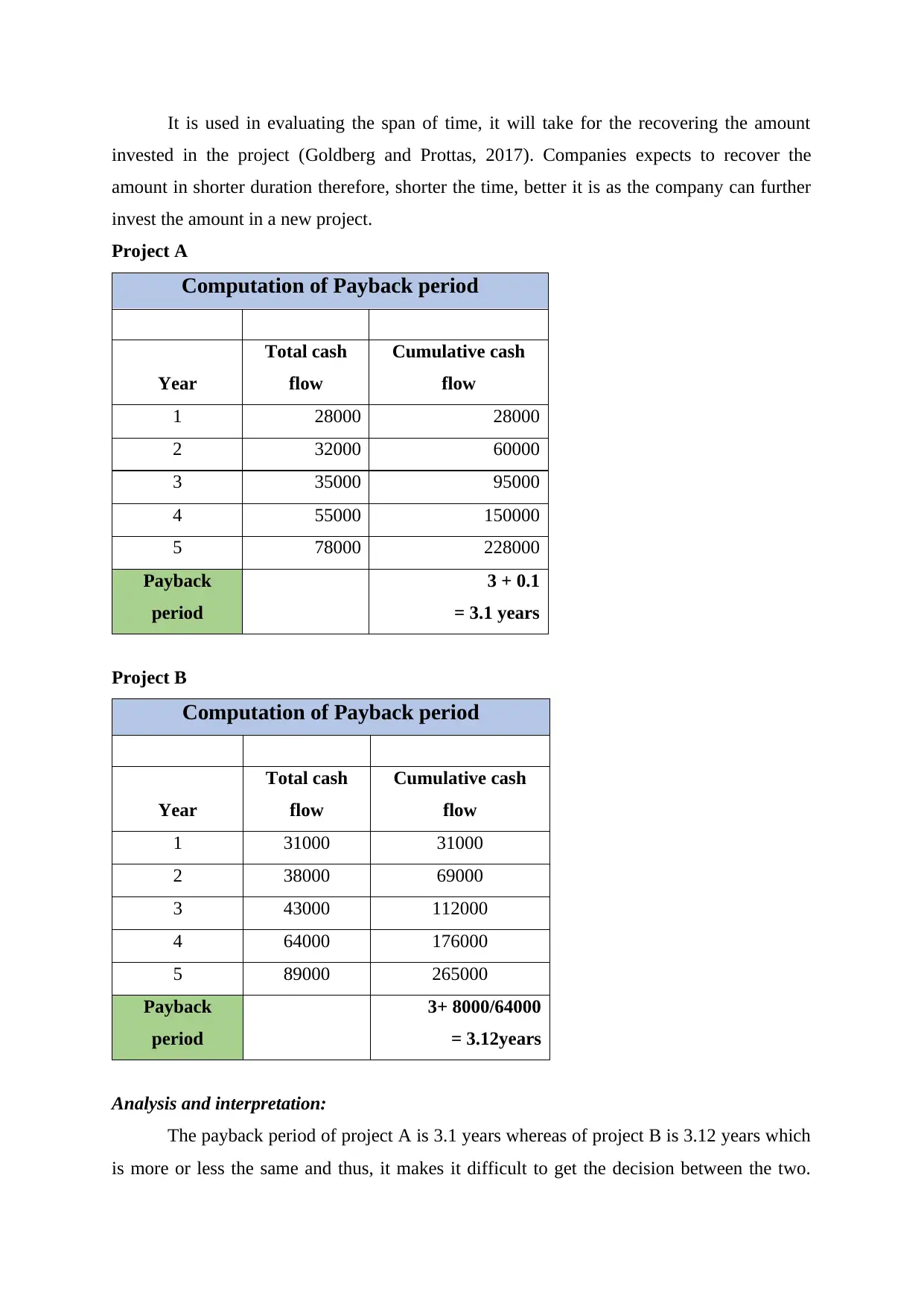Investment Profitability Analysis for XYZ plc: A Financial Report
VerifiedAdded on 2023/01/11
|7
|1231
|79
Report
AI Summary
This report provides a detailed financial analysis of investment proposals for XYZ plc, focusing on determining project profitability. The analysis utilizes two primary investment appraisal techniques: Net Present Value (NPV) and Payback Period. The NPV method is employed to assess the present value of future cash inflows against the initial investment for two projects, Project A and Project B, and the results are interpreted to guide the investment decision. The payback period is calculated to determine the time required to recover the initial investment for both projects. The report then discusses the advantages and disadvantages of each method, providing a comparative analysis to support the final investment recommendation. Furthermore, the report extends beyond financial metrics, emphasizing the importance of considering non-financial factors such as operational feasibility, technological trends, market conditions, and availability of skilled staff. The conclusion recommends Project B as the preferred investment based on the financial analysis and the consideration of other key factors. The report underscores the significance of a comprehensive approach to investment decision-making within XYZ plc.

Business Decision Making
Paraphrase This Document
Need a fresh take? Get an instant paraphrase of this document with our AI Paraphraser

TABLE OF CONTENTS
Determining the profitability of investment proposals for XYZ plc......................................3
Effect of financial and non-financial factors used in decision making..................................6
REFERENCES...........................................................................................................................7
Determining the profitability of investment proposals for XYZ plc......................................3
Effect of financial and non-financial factors used in decision making..................................6
REFERENCES...........................................................................................................................7

The investment based decision making is an important part of business as it is the key
function of the management to take proper business decisions. These decisions might be for
business expansion or contraction. This essay provides an in depth understanding of various
investment appraisal techniques based on which the investment plan of XYZ plc will be
taken.
Determining the profitability of investment proposals for XYZ plc
The company will be using net present value and payback period approach for the
purpose of evaluating the profitability associated with the two projects.
Net present value
It is the capital budgeting strategy which considers the current estimation of income
for deciding the productivity related with the task. It is the difference between the current
estimation of cash inflow and cash outflow (Pichugina, 2016). The positive NPV
demonstrates that the organization can continue with its investment plan and put resources
into it. Then again, the negative NPV shows that the venture isn't beneficial and attainable for
the business.
Project A
Computation of NPV
Year Cash inflows
PV factor
@ 11%
Discounted
cash
inflows
1 28000 0.901 25225.2
2 32000 0.812 25972
3 35000 0.731 25592
4 55000 0.659 36230
5 78000 0.593 46289
Total discounted cash
inflow 159308
Initial investment 100000
NPV (Total
discounted cash
inflows - initial
investment) 59308
function of the management to take proper business decisions. These decisions might be for
business expansion or contraction. This essay provides an in depth understanding of various
investment appraisal techniques based on which the investment plan of XYZ plc will be
taken.
Determining the profitability of investment proposals for XYZ plc
The company will be using net present value and payback period approach for the
purpose of evaluating the profitability associated with the two projects.
Net present value
It is the capital budgeting strategy which considers the current estimation of income
for deciding the productivity related with the task. It is the difference between the current
estimation of cash inflow and cash outflow (Pichugina, 2016). The positive NPV
demonstrates that the organization can continue with its investment plan and put resources
into it. Then again, the negative NPV shows that the venture isn't beneficial and attainable for
the business.
Project A
Computation of NPV
Year Cash inflows
PV factor
@ 11%
Discounted
cash
inflows
1 28000 0.901 25225.2
2 32000 0.812 25972
3 35000 0.731 25592
4 55000 0.659 36230
5 78000 0.593 46289
Total discounted cash
inflow 159308
Initial investment 100000
NPV (Total
discounted cash
inflows - initial
investment) 59308
⊘ This is a preview!⊘
Do you want full access?
Subscribe today to unlock all pages.

Trusted by 1+ million students worldwide

Project B
Computation of NPV
Year
Cash
inflows
PV factor
@ 11%
Discounted
cash
inflows
1 31000 0.901 27927.9
2 38000 0.812 30842
3 43000 0.731 31441
4 64000 0.659 42159
5 89000 0.593 52817
Total discounted cash
inflow 185187
Initial investment 120000
NPV (Total discounted
cash inflows - initial
investment) 65187
Analysis and interpretation:
The NPV of both the projects is positive which indicates that the XYZ plc should
invest in the projects but the company needs to make a choice between these two. On
comparing the NPV of these two projects it can be said that the NPV of project B is £65187
which is higher than NPV of project A which is £59308. This method of evaluation has
various benefits which makes it preferable by the organizations. It takes into consideration
time factors for determining the present value of future cash inflows. The discounting rate
can eb adjusted with respect to the risk prevailing in the market and also it considers the cash
inflow across the life of the project. This method is considered to be logical as unlike IRR, it
does not consider that the cash flows will be reinvested in the market.
Along with benefits, it also has certain drawbacks. While determining the feasibility
of the project with longer time frame, there are chances of getting inaccurate cash flow
estimates. Also, the even a minor change in the discounting rate will affect the end result and
the decision taken based on it will turn out to be wrong and might incur losses.
Payback period
Computation of NPV
Year
Cash
inflows
PV factor
@ 11%
Discounted
cash
inflows
1 31000 0.901 27927.9
2 38000 0.812 30842
3 43000 0.731 31441
4 64000 0.659 42159
5 89000 0.593 52817
Total discounted cash
inflow 185187
Initial investment 120000
NPV (Total discounted
cash inflows - initial
investment) 65187
Analysis and interpretation:
The NPV of both the projects is positive which indicates that the XYZ plc should
invest in the projects but the company needs to make a choice between these two. On
comparing the NPV of these two projects it can be said that the NPV of project B is £65187
which is higher than NPV of project A which is £59308. This method of evaluation has
various benefits which makes it preferable by the organizations. It takes into consideration
time factors for determining the present value of future cash inflows. The discounting rate
can eb adjusted with respect to the risk prevailing in the market and also it considers the cash
inflow across the life of the project. This method is considered to be logical as unlike IRR, it
does not consider that the cash flows will be reinvested in the market.
Along with benefits, it also has certain drawbacks. While determining the feasibility
of the project with longer time frame, there are chances of getting inaccurate cash flow
estimates. Also, the even a minor change in the discounting rate will affect the end result and
the decision taken based on it will turn out to be wrong and might incur losses.
Payback period
Paraphrase This Document
Need a fresh take? Get an instant paraphrase of this document with our AI Paraphraser

It is used in evaluating the span of time, it will take for the recovering the amount
invested in the project (Goldberg and Prottas, 2017). Companies expects to recover the
amount in shorter duration therefore, shorter the time, better it is as the company can further
invest the amount in a new project.
Project A
Computation of Payback period
Year
Total cash
flow
Cumulative cash
flow
1 28000 28000
2 32000 60000
3 35000 95000
4 55000 150000
5 78000 228000
Payback
period
3 + 0.1
= 3.1 years
Project B
Computation of Payback period
Year
Total cash
flow
Cumulative cash
flow
1 31000 31000
2 38000 69000
3 43000 112000
4 64000 176000
5 89000 265000
Payback
period
3+ 8000/64000
= 3.12years
Analysis and interpretation:
The payback period of project A is 3.1 years whereas of project B is 3.12 years which
is more or less the same and thus, it makes it difficult to get the decision between the two.
invested in the project (Goldberg and Prottas, 2017). Companies expects to recover the
amount in shorter duration therefore, shorter the time, better it is as the company can further
invest the amount in a new project.
Project A
Computation of Payback period
Year
Total cash
flow
Cumulative cash
flow
1 28000 28000
2 32000 60000
3 35000 95000
4 55000 150000
5 78000 228000
Payback
period
3 + 0.1
= 3.1 years
Project B
Computation of Payback period
Year
Total cash
flow
Cumulative cash
flow
1 31000 31000
2 38000 69000
3 43000 112000
4 64000 176000
5 89000 265000
Payback
period
3+ 8000/64000
= 3.12years
Analysis and interpretation:
The payback period of project A is 3.1 years whereas of project B is 3.12 years which
is more or less the same and thus, it makes it difficult to get the decision between the two.

Thus, the company can go for any of the two projects based on NPV. The longer payback
period indicates that the capital is being tied up and reduces the opportunity to invest in
another project. It is preferred because it is very easy to calculate.
On the other hand, it has some limitations as well. It does not take account of time
value of money while determining the payback period. Also, it ignores the cash flow after the
payback period and also ignores the residual value of the asset at the end of the project.
Based on the above, the NPV method seems to the right choice for taking the
decisions as the payback period for both the project is approximately same. Thus, XYZ plc
should invest in the project B.
Effect of financial and non-financial factors used in decision making
Apart from the above discussed financial points, the XYZ plc should also analyse
some of the key non-financial factors as it will assist in determining whether the investment
will yield positive outcome or not (Roy and Hota, 2016). The key factors that XYZ plc
should consider before taking any decision are stated below.
Whether company would be able run the service in-house effectively or not.
Future trend with respect to the services being offered by it with respect to
upgradation in the technology or the software which might make the current
technology out dated or less useful.
The economic condition of the market and the effect of positive or negative change in
the condition over the business activities.
Staff with required skill sets would be available or not for managing the services.
It can be summed up from the above that it is very essential for the businesses to consider
all types of factor whether financial and non-financial while making decision as both has a
great influence over the decisions. As per the case provided, XYZ plc should invest in the
project B as the amount of net present value is positive and higher than project B. Also, other
non-financial should also be considered before making a final call which is very essential.
Thus, decision making is an important part of an organization.
period indicates that the capital is being tied up and reduces the opportunity to invest in
another project. It is preferred because it is very easy to calculate.
On the other hand, it has some limitations as well. It does not take account of time
value of money while determining the payback period. Also, it ignores the cash flow after the
payback period and also ignores the residual value of the asset at the end of the project.
Based on the above, the NPV method seems to the right choice for taking the
decisions as the payback period for both the project is approximately same. Thus, XYZ plc
should invest in the project B.
Effect of financial and non-financial factors used in decision making
Apart from the above discussed financial points, the XYZ plc should also analyse
some of the key non-financial factors as it will assist in determining whether the investment
will yield positive outcome or not (Roy and Hota, 2016). The key factors that XYZ plc
should consider before taking any decision are stated below.
Whether company would be able run the service in-house effectively or not.
Future trend with respect to the services being offered by it with respect to
upgradation in the technology or the software which might make the current
technology out dated or less useful.
The economic condition of the market and the effect of positive or negative change in
the condition over the business activities.
Staff with required skill sets would be available or not for managing the services.
It can be summed up from the above that it is very essential for the businesses to consider
all types of factor whether financial and non-financial while making decision as both has a
great influence over the decisions. As per the case provided, XYZ plc should invest in the
project B as the amount of net present value is positive and higher than project B. Also, other
non-financial should also be considered before making a final call which is very essential.
Thus, decision making is an important part of an organization.
⊘ This is a preview!⊘
Do you want full access?
Subscribe today to unlock all pages.

Trusted by 1+ million students worldwide

REFERENCES
Books and Journals
Goldberg, R. S. and Prottas, D. J., 2017. Capital Investment Analytical Techniques in Higher
Education: A Factor in the Cost Growth?. Journal of Managerial Issues. 29(4). pp.414-
320.
Pichugina, O., 2016. Combinatorial approaches to the capital-budgeting
problem. ECONTECHMOD: An International Quarterly Journal on Economics of
Technology and Modelling Processes. 5.
Roy, D. and Hota, D. C. H. D. C., 2016. DCF, Strategic Approach and Multi-Factor Model:
An Empirical Study to Explore a Rational Approach to Capital Budgeting. T INDIAN
JOURNAL HE OF COMMERCE. 69(4).
Books and Journals
Goldberg, R. S. and Prottas, D. J., 2017. Capital Investment Analytical Techniques in Higher
Education: A Factor in the Cost Growth?. Journal of Managerial Issues. 29(4). pp.414-
320.
Pichugina, O., 2016. Combinatorial approaches to the capital-budgeting
problem. ECONTECHMOD: An International Quarterly Journal on Economics of
Technology and Modelling Processes. 5.
Roy, D. and Hota, D. C. H. D. C., 2016. DCF, Strategic Approach and Multi-Factor Model:
An Empirical Study to Explore a Rational Approach to Capital Budgeting. T INDIAN
JOURNAL HE OF COMMERCE. 69(4).
1 out of 7
Related Documents
Your All-in-One AI-Powered Toolkit for Academic Success.
+13062052269
info@desklib.com
Available 24*7 on WhatsApp / Email
![[object Object]](/_next/static/media/star-bottom.7253800d.svg)
Unlock your academic potential
Copyright © 2020–2025 A2Z Services. All Rights Reserved. Developed and managed by ZUCOL.





